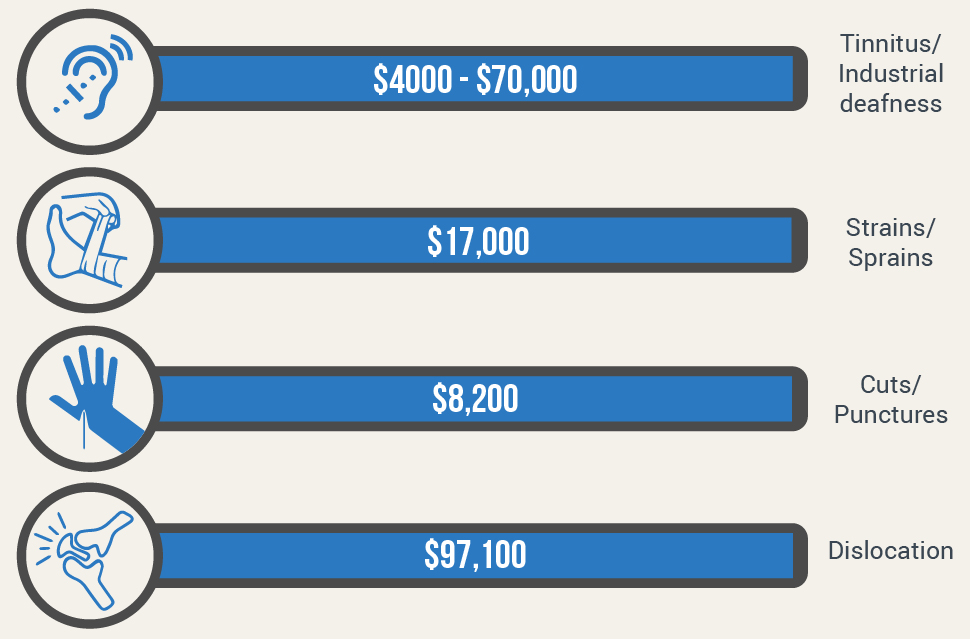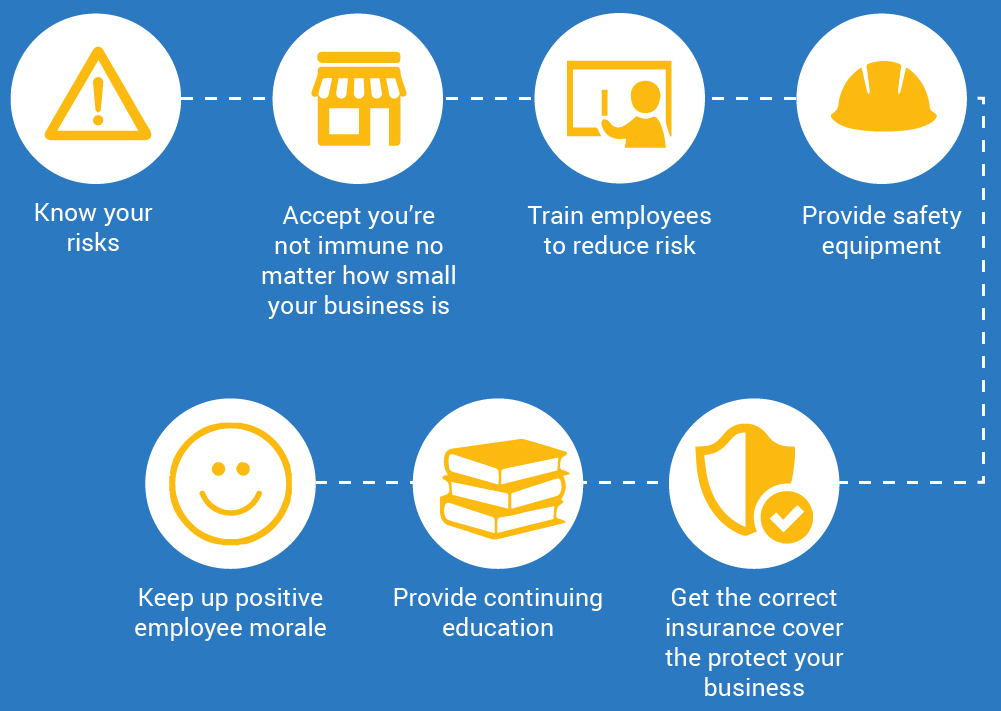Keeping your employees happy is probably one of your highest priorities as a business owner. Providing them with competitive pay and benefits is only part of the solution. In addition, you are responsible for creating a workplace that is as safe as possible. By so doing, you can minimize the chance of workplace injuries that can be ruinous both to your business and to the injured party.
(info-graphic below article)
The absolutely worst case scenario is a fatality on the job. Sadly, 4,405 employees lost their lives during the course of their duties in 2013 alone. Millions more were badly hurt at their workplaces. In order to protect both yourself and your employees, it is crucial that you invest in worker’s compensation coverage. This insurance will pay an injured employee’s covered medical expenses and can even provide the person with financial assistance to cover lost wages during convalescence. In return for this benefit, the employee is prevented from suing you for liability, a potential savings of hundreds of thousands of dollars in fees for legal counsel and damages.
MOST COMMON WORKPLACE INJURIES AND COST PER CLAIM

• Tinnitus/industrial deafness. Hearing loss and constant ringing in an employee’s ears due to noisy workplace conditions can take a major toll. While hearing aids can help to minimize the effects in some cases, they are by no means a perfect solution. This condition is often a permanent disability that can lead to social isolation and diminished competence.
• Strains and sprains. Although temporary, these conditions are still painful and can severely limit a person’s ability to ambulate and perform his or her duties. Returning to work too soon can aggravate the condition and lead to a more extended absence.
• Cuts and punctures can occur for many reasons, including employee carelessness and equipment malfunction. If you suspect that your employee was hurt due to the latter, keep in mind that it is your responsibility to maintain all workplace equipment. That means regular inspections and timely replacement when the need arises.
• Dislocations are painful and can lead to long-term damage and the need for rehabilitation and physical therapy. Training all employees in the correct physical motions involved in completing work-related tasks can help to cut back on the likelihood of these types of injuries.
HOW WORKPLACE INJURIES OCCUR

• Too much exposure to noise pollution. If the environment in your facility is loud, particularly if you constantly run noisy equipment, your workers may suffer in the long run. As we saw above, hearing loss frequently occurs in many industries. Help to protect everyone’s hearing by providing high-quality ear plugs, and do what you can to upgrade your machinery to quieter models.
• On-the-job violent acts by a disgruntled employee. Although relatively rare, employee-on-employee violence still makes the headlines several times each year. Minimize your risk by adopting and publicizing a violence prevention policy. Establish and enforce clear codes of conduct. If conflicts arise, take immediate measures to nip them in the bud. Make sure the lines of communication are open, and keep your ear to the ground for rising tensions. Finally, encourage team-building and tolerance.
• Repetitive motion injuries. Whether your employees sit at keyboards all day, operate sewing machines or some other types of mechanisms, they can acquire painful harm to tendons and muscles that sometimes needs surgical intervention to cure. Providing ergonomic modifications and varying work activities can help.
• Machine entanglements. These often horrifying injuries can happen if a worker is overly fatigued or is attempting to multi-task. Keep an eye on your workers to minimize the chances of these injuries. If your responsibilities prevent you from doing so, assign this important duty to someone you trust.
• Vehicle accidents. If your workers drive as a part of their jobs, make sure they are covered by adequate auto insurance, either on your business’s policy or their own personal one.

• Walking into injuries. Keep your environment free from extraneous obstacles to reduce these types of accidents.
• Injuries caused by a falling object. Encourage your employees to remain watchful of the environment around them to lessen the likelihood of this injury.
• Reaction injuries occur when your employee tries to avoid being hurt by something else.
• Falling from heights and slips and trips can occur if a worker is distracted, overwhelmed or fatigued.

• Over-exertion injuries can be minimized through thorough on-the-job training and open lines of communication between workers and supervisors.
• Fatigue and stress. These account for many accidents. Keeping dialogue open with workers and monitoring performance can help.
• Exposure to hazardous materials. Protecting your employees from dangerous substances is your responsibility.
• Lifting. Improper techniques employed in picking up heavy objects can lead to debilitating, long-term back and shoulder injuries. This underscores the importance of thorough job training.
HOW MUCH COMMON WORKPLACE INJURIES COST BUSINESSES
Billions of dollars are spent each year on the consequences of accidents and injuries in the workplace. While some are unavoidable, there are steps you can take to lower your and your employees’ risks.

AVOIDING INJURIES

• Know your risks. Each industry contains some level of risk. Take the time to assess your workers’ job responsibilities and equipment to determine how susceptible you may be.
• Understand that accidents can happen no matter how well prepared you may be. This underscores the need for comprehensive, industry-specific business insurance.
• Provide instruction to your staff in all aspects of their jobs to keep the risk of injuries as low as possible.
• Whenever you can, furnish your staff with safety equipment such as goggles, ear plugs and work gloves.
• Obtain proper insurance coverage. Sometimes you do get what you pay for, but it never hurts to shop around for the best rates – as long as the policy protects you and your employees and takes your industry-specific risk into account.
• Never stop educating yourself and your workers. Protocols and technologies change, and it pays to keep current.
(click to enlarge)
Embed This Infographic
Copy and paste the code below to get this infographic onto your website or blog.


